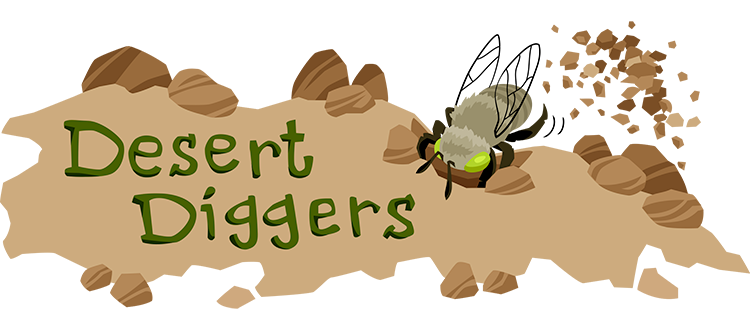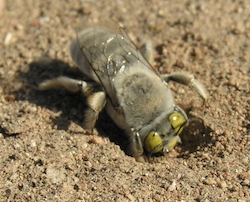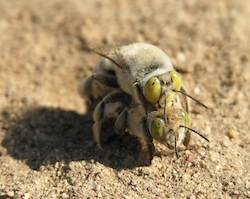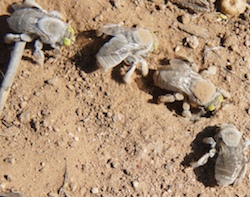
Illustrated by: Sabine Deviche
The Macho Bees of the Desert

When most people hear "bee," they automatically think only of the honey bee. This bee species was imported to the United States long ago to provide beekeepers with honey.
The honey bee dominates the bee news today thanks to its economic importance as a crop pollinator and the sharp drop in honey bee populations in recent years. Whether as honey producer, pollinator, or contributor to our fascination with unsolved mysteries, the honey bee overshadows all other bees in the Americas. And yet there are a great many other bee species that did not need to be brought here from other continents.
According to the Xerces Society, an insect conservation group, more than 4000 species of bees live naturally in the United States alone. These range in size from minute creatures so small that they are difficult to see with the unaided eye to jumbo bees, like the big black carpenter bees that always get a response when they cruise up to someone seated in a patio chair in carpenter bee country.

One mid-sized species (bigger than a honey bee but smaller than a bumble bee) that is common in central Arizona, although little appreciated here, goes by the scientific name Centris pallida. Unlike the honey bee, this native bee has no universally accepted common name and so we are free to call it the "digger bee" in honor of its habit of digging in desert soils.
The digger bee is just one of about a thousand species of native bees in Arizona, many of which have females that burrow into the ground with their jaws and legs when constructing a nest. They do this hard work entirely by themselves without the benefit of helpful worker bees. In contrast, honey bee colonies are composed primarily of self-sacrificing worker bees, which assist the queen bee in the various tasks needed to produce future queens and kings (which are called drones).
The Life of A Male Bee

Female digger bees spend their adulthood nest-building and provisioning brood cells. In contrast, males do nothing to help the females create the next new generation of digger bees. Instead, they typically tunnel upward from their brood cells slightly before most females emerge in spring. The adult males then spend their mornings cruising low over open areas close to where they themselves had spent the previous year underground.
Often dozens or even hundreds of males fly in slow looping circles over the same grassy or sandy plot of land where their mothers nested by the dozens or hundreds in the preceding year. The males are hunting for the females that will also emerge in this area, which they can do before the females have made it to the surface!
I discovered this remarkable ability in the early 1970s when I happened upon an emergence site where many males were active, although I didn't know then that they were males. In fact, when I saw numbers of big grey bees circling around close to the ground, I assumed they were female bees looking for a place to dig their nests.
My assumption seemed confirmed when I saw some individuals start digging in the soil. As I watched one digger at work, I was taken aback when the bee paused for a moment and another bee came bursting up from the mini-burrow that the digger had constructed.

The bee that had been digging immediately climbed on the back of other bee, at which point I realized that I was looking at a male that had found and dug down to meet an emerging female, helping her out in order to mate with her.
As you may know, a majority of native bees mate on flowers, which the males patrol searching for females willing and able to mate with them. But in a considerable number of species, including Centris pallida, males hunt for mates in areas that once were used by many nesting females as they created the next generation of bees. However, at the time I found the males of Centris pallida at work, no cases were known of male bees that were capable of locating mates concealed in unopened emergence tunnels.
It's not surprising that no one had learned about the digger bee's special abilities prior to my research. After all, there is a huge number of bee species in Arizona and a small number of Arizonan entomologists. Since I had the bee all to myself, I naturally wanted to find out how males managed to find females beneath an inch or so of hard packed desert soil. Here was a fine puzzle for any entomologist.
Finding Underground Females

You might wonder how to figure out how male digger bees can find females hidden under a blanket of earth. I had two ideas. One was that the males heard the females scraping away the soil with their jaws as they dug themselves up to the surface. Another was the males smelled the females as they neared the surface. I favored the second explanation because I could see males putting their antennae, the devices with which insects smell odors, close to the ground before beginning to bite at the soil prior to kicking it away as they dug downward.
If I was right, I knew that I could trick males into digging up freshly killed females that were covered by an inch or so of dirt and so could not be seen by the patrolling males. These females would still have some scents on their bodies but they could not make sounds to alert a male of their presence. Sure enough, my simple experiments revealed that cruising males had no problem locating and digging up immobile females of their species, a finding that indicates that odor alone provides a sufficient cue for males to find potential mates. Their antennae must be extremely sensitive to scents that trickle up through the soil from the body of an emerging female.
The ability to smell females before they emerge raises another kind of question that entomologists can try to answer: Why has the male of Centris pallida evolved such extreme sensitivity to the odors associated with emerging females?
The bee Centris pallida provided me with many hours of enjoyment as I have tried to figure out how and why the macho males behave the way they do. The digger bee may be just one of thousands of non-honey bees but it is every bit as wonderful in its own right as the more familiar honey bee. Moreover, whereas honey bees have been subjected to intense research scrutiny by literally thousands of entomologists and other biologists, Centris pallida and the host of other native bees have been largely ignored. So you and I can make real contributions to our knowledge about life on earth by picking a native bee and studying what it does. Here are some trips and tricks on studying bees. Go for it!
About the author and photographer: John Alcock is a behavioral ecologist and an emeritus faculty member of the School of Life Sciences. He is also the author of more than a half dozen books including:When the Rains Come: A Naturalist's Year in the Sonoran Desert.
Read more about: Desert Diggers
Bibliographic details:
- Article: Desert Diggers
- Author(s): John Alcock
- Publisher: Arizona State University School of Life Sciences Ask A Biologist
- Site name: ASU - Ask A Biologist
- Date published:
- Date accessed:
- Link: https://askabiologist.asu.edu/explore/desert-digger-bees
APA Style
John Alcock. (). Desert Diggers. ASU - Ask A Biologist. Retrieved from https://askabiologist.asu.edu/explore/desert-digger-bees
Chicago Manual of Style
John Alcock. "Desert Diggers". ASU - Ask A Biologist. . https://askabiologist.asu.edu/explore/desert-digger-bees
John Alcock. "Desert Diggers". ASU - Ask A Biologist. . ASU - Ask A Biologist, Web. https://askabiologist.asu.edu/explore/desert-digger-bees
MLA 2017 Style

These bees really can dig. By weight they compete with the best digging dog.
Be Part of
Ask A Biologist
By volunteering, or simply sending us feedback on the site. Scientists, teachers, writers, illustrators, and translators are all important to the program. If you are interested in helping with the website we have a Volunteers page to get the process started.


